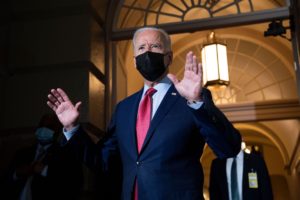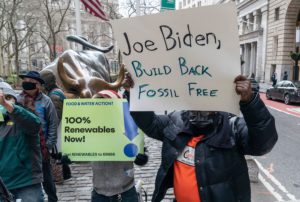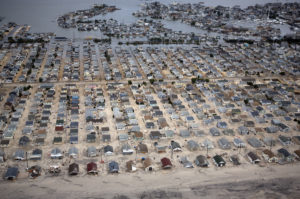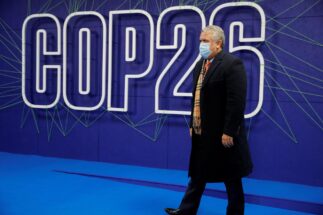President Biden will arrive at the international climate negotiations in Glasgow with a target of halving US greenhouse gas emissions by the end of the decade, and armed with a long list of federal government proposals and plans. Biden promised to “lead the world in addressing the climate emergency” and it’s clear that he’s trying. But, back home, congressional negotiations have cut support for clean energy. And with only a year to go before crucial midterm elections, the best chance to pass comprehensive climate policy in twelve years may be slipping away.
Biden’s Build Back Better plan, as initially envisaged, was set to be a gigantic investment in 21st-century infrastructure across the United States. At the heart of it was a plan to clean up US energy – the Clean Energy Performance Program (CEPP).
A majority of voters support the clean energy policies and Build Back Better. But Democrats have the thinnest possible margin in the Senate. This has amplified the power of a few dissenters in the ranks, including Senator Joe Manchin of West Virginia, who has reportedly threatened to leave the party if clean energy provisions aren’t removed. Manchin, from a Trump-voting, coal-producing state, also benefits from a family-owned coal brokerage and has little incentive to change.
The question now is not whether Build Back Better will be watered down, but by how much. And, if it is, can the US hit its climate targets? An analysis from consulting firm Rhodium suggests it is possible, though this would require faster annual cuts in emissions than have ever happened before, outside of an economic recession.
Just before departing for Glasgow, President Biden seemed to have struck a deal with his senators, which included proposals for US$550 billion in climate spending, but removed the CEPP.
A smaller infrastructure bill, which includes some support for clean energy and electric vehicles is still likely to pass. A mixture of executive actions and regulations can also make a substantial dent in emissions and don’t require congressional approval – starting with tightening fuel economy standards for cars and trucks, and following up an important new climate report from the Treasury by implementing a series of financial regulations that may ultimately limit lending to fossil fuels.
Repairing the damage
On the international stage the US has committed to substantially increase international climate finance, though its pledge of US$11.4 billion a year falls well short when compared to other countries, in terms of the US’s economic size and greenhouse gas emissions. Biden’s government has also been a driving force behind the formation of the Global Methane Pledge, which commits countries to slash methane emissions 30% by 2030. Methane’s heat-trapping impact is much more powerful than carbon dioxide but also much shorter-lived. Many of these emissions, at least in the US oil and gas sector, could be dealt with relatively simply using existing technology.
US leverage on climate, among a host of other diplomatic and trade issues, has been sharply reduced after the disastrous presidency of Donald Trump. Inconsistent and incomplete support for developing countries on vaccines and the as yet unfunded Build Back Better World infrastructure initiative have done little to repair the damage. It also doesn’t help that the US continues to export fossil fuels. The country is now the third-largest exporter of liquefied natural gas and is building new terminals to export more, adding greenhouse gases to the atmosphere that appear on the ledger of other countries. In Louisiana and Texas, this is also increasing local pollution, and hurting the health of poorer communities of colour who live near the facilities.
The US may be back at the table under President Biden, but sceptical world leaders could be forgiven for asking, for how long?
Biden’s special envoy on climate change, John Kerry, has been trying to exert diplomatic pressure on countries including Brazil, Saudi Arabia, India and, most of all, China, to bring stronger targets to the table, along with plans to meet them. There has been some progress. Saudi Arabia recently announced plans to reach “net zero emissions” by 2060, though this won’t count emissions from the oil they continue to export. China has brought a new nationally determined contribution (NDC) to Glasgow, although it does not upgrade previously announced targets; India is expected to follow suit. For his part, Kerry admitted that the US failing to pass climate policy at home “would be like President Trump pulling out of the Paris agreement, again”.
This comparison is apt. For many other countries, the US may now have reneged on climate deals one too many times. President Bill Clinton helped craft the 1997 Kyoto Protocol, though this was swiftly followed by the Byrd-Hagel resolution – led by another Democratic senator from West Virginia – which resolved to vote against signing the treaty, or any agreement to limit emissions. George W Bush then said he wouldn’t try to meet Kyoto targets. Barack Obama helped put together the Paris Agreement, but Republican president Trump then promptly withdrew.
The US may be back at the table under President Biden, but sceptical world leaders could be forgiven for asking, for how long? Current arguments about climate finance and how much the US pays to developing countries, for example, are informed by the grim realisation that the moment the Democrats lose Congress or the presidency, such money is likely to dry up.
The US is still responsible for the largest historical share of emissions in the atmosphere and is the second-largest annual emitter. There’s a climate debt to be paid. With doubts around US commitment, President Biden may now be unable to lead the world in addressing the climate emergency, but if he were successful in leading such action in the US, that would be a great start.









